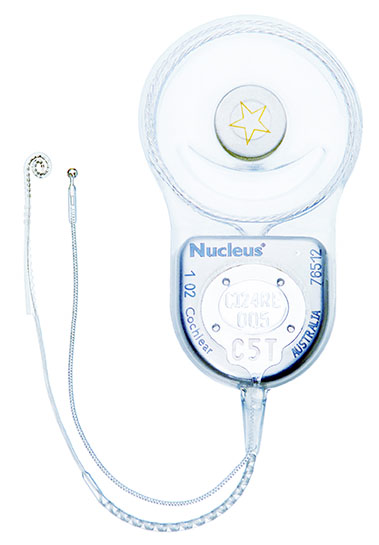 A cochlear implant is an implanted electronic hearing device, designed to produce useful hearing sensations to a person with severe to profound nerve deafness by electrically stimulating nerves inside the inner ear. Cochlear implants are designed to help severely to profoundly deaf adults and children who get little or no benefit from hearing aids. Even individuals with severe or profound “nerve deafness” may be able to benefit from cochlear implants. Currently made devices have a magnet that holds the external system in place next to the implanted internal system. The external system may be worn entirely behind the ear or its parts may be worn in a pocket, belt pouch, or harness.
A cochlear implant is an implanted electronic hearing device, designed to produce useful hearing sensations to a person with severe to profound nerve deafness by electrically stimulating nerves inside the inner ear. Cochlear implants are designed to help severely to profoundly deaf adults and children who get little or no benefit from hearing aids. Even individuals with severe or profound “nerve deafness” may be able to benefit from cochlear implants. Currently made devices have a magnet that holds the external system in place next to the implanted internal system. The external system may be worn entirely behind the ear or its parts may be worn in a pocket, belt pouch, or harness.
These implants usually consist of two main components:
- The externally worn microphone, sound processor and transmitter system.
- The implanted receiver and electrode system, which contains the electronic circuits that receive signals from the external system and send electrical currents to the inner ear.
Many things determine the success of implantation. Some of them are:
- How long the patient has been deaf–as a group, patients who have been deaf for a short time do better than those who have been deaf a long time
- How old they were when they became deaf–whether they were deaf before they could speak
- How old they were when they got the cochlear implant–younger patients, as a group, do better than older patients who have been deaf for a long time
- How long they have used the implant
- How quickly they learn
- How good and dedicated their learning support structure is
- The health and structure of their cochlea–number of nerve (spiral ganglion) cells that they have
- Implanting variables, such as the depth and type of implanted electrode and signal processing technique
- Intelligence and communicativeness of patient
How Does a Cochlear Implant Work?
A cochlear implant receives sound from the outside environment, processes it, and sends small electric currents near the auditory nerve. These electric currents activate the nerve, which then sends a signal to the brain. The brain learns to recognize this signal and the person experiences this as “hearing”.
The cochlear implant somewhat simulates natural hearing, where sound creates an electric current that stimulates the auditory nerve. However, the result is not the same as normal hearing.
How Do I Know If a Cochlear Implant Is Right for Me?
Your audiologist will be able to tell you if your hearing loss may warrant a cochlear implant and he/she will refer you to an otolaryngologist (ENT) to determine your eligibility for an implant. If you might be a candidate, you will undergo a hearing aid trial before determining if you are a candidate. If you are in the San Francisco Bay Area, we recommend attending our Cochlear Implants Support Group to learn more about the challenges, risks, and benefits of a cochlear implant.
Cochlear Implant Support Group
The Cochlear Implant Support Group typically meets quarterly. Click here for more information or visit our events calendar for upcoming meetings.
